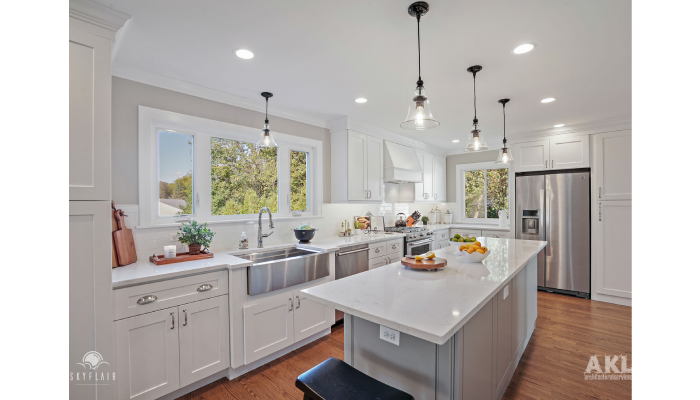Architectural 3D animation is really changing the game when it comes to visualizing designs. This technology lets clients walk through spaces before they are built, creating a compelling narrative that brings designs to life. Unlike static images, animations show depth and flow, engaging viewers with movement, light, and sound. This all aids in decision-making for stakeholders involved. Companies like OMEGARENDER and ZOA Studio stand out by focusing on storytelling and quality visuals tailored to clients’ needs. Moreover, advancements in VR and AR make experiences even more immersive. As competition grows, investing in these services is becoming essential for effective project presentations.
Understanding 3D Architectural Animation
3D architectural animation is a digital technique that transforms architectural designs into engaging, dynamic visualizations. This allows clients to immerse themselves in the space, experiencing it as if they were physically present. The primary purpose of this animation is to convey the design intent clearly, enhancing storytelling and helping stakeholders visualize the final outcome before any construction takes place. Historically, architectural animation has evolved from static images and simple drawings to complex, realistic visual narratives that combine movement, light, and sound. In contemporary practice, various styles of 3D animation exist, ranging from photorealistic walkthroughs to stylized animations that emphasize artistic concepts.
When comparing 3D animation to traditional architectural visualization, the former offers a more dynamic representation of spaces, showcasing depth and flow in a way that static images cannot. This is particularly beneficial in client presentations, where captivating animations can significantly elevate marketing strategies and client engagement. Real-world applications of 3D architectural animation span a wide range of projects, including residential developments, commercial spaces, urban planning, and landscape visualization. These animations not only assist in client presentations but also serve as powerful marketing tools that can attract potential buyers and investors.
Moreover, 3D animation plays a vital role in urban planning and landscape design, helping stakeholders visualize how new developments will integrate with existing environments. The integration of advanced design tools and software, such as Autodesk and 3ds Max, enhances the quality and detail of these animations, allowing for realistic representations. Success stories abound, showcasing how effective 3D animations have influenced project approvals and client decisions. Positive client testimonials often highlight the clarity and engagement that these animations bring to the design process, underscoring their importance in today’s architectural landscape.
Benefits of 3D Animation Services
3D animation services offer significant advantages in the architectural field. They enhance the understanding of complex designs, allowing clients and stakeholders to visualize projects in a way that static images cannot. This dynamic visualization is especially beneficial during presentations, as it fosters better communication among architects, clients, and developers. By providing a clear representation of the design intent, these animations serve as a crucial decision-making tool, helping everyone involved grasp the project’s scope and details.
Moreover, 3D animations can be powerful marketing tools. They create memorable experiences for potential buyers, showcasing properties in an engaging manner that captures attention. This can be particularly impactful in competitive markets, where first impressions are vital. The ability to explore various design options before construction begins also streamlines the process, saving time and resources during design reviews.
Incorporating virtual reality walkthroughs adds an immersive layer to the experience, enabling clients to feel as though they are truly walking through the space. This not only enhances their connection to the project but also builds stronger client relationships through detailed visual presentations. With easy sharing capabilities across various platforms, these animations can reach a wider audience, making them an invaluable asset for any architectural project.
- Enhances understanding of complex architectural designs
- Facilitates better communication among project stakeholders
- Helps in marketing and sales strategies for properties
- Allows for exploration of design options before construction
- Creates a memorable experience for potential buyers
- Supports virtual reality walkthroughs for immersive experiences
- Saves time and resources in the design review process
- Improves accuracy in visualizing design intent
- Enables easy sharing of projects across various platforms
- Builds stronger client relationships through detailed visual presentations
Top Companies in Architectural Animation
OMEGARENDER excels in crafting architectural animations tailored for architects, designers, and developers. Their structured workflow includes material collection, scripting, and post-production, ensuring a narrative that highlights property strengths. ZOA Studio stands out with its high-end animations, creating unique packages like the “Impression Package” for efficient delivery of multiple high-resolution renders. RealSpace 3D, with over 17 years in the field, focuses on quality and customization, providing a dedicated project manager for each client. Their services include exterior and interior renderings, 3D floor plans, and virtual tours, emphasizing alignment with client specifications. Vrender, also with 17 years of experience, prioritizes photorealism and collaboration, delivering high-quality visuals that are ideal for presentations.
When comparing pricing models, transparency is key, with costs influenced by video dynamics, length, and complexity. Each company has a distinct client base, ranging from high-profile developers to individual architects, showcasing their specialties through impressive project portfolios. For instance, ZOA Studio’s signature animations often attract attention in luxury markets, while RealSpace 3D’s commitment to detail appeals to those needing customized solutions.
Leading studios utilize advanced software tools like Autodesk and 3ds Max, allowing them to achieve remarkable levels of detail and realism. The integration of VR and AR technologies also enhances the experience, making animations more interactive. Among these established players, emerging studios are beginning to carve out their niche, contributing fresh perspectives and innovative techniques to architectural visualization.
The Animation Production Process
The animation production process is a structured journey that begins with pre-production and unfolds through production and post-production phases. In the pre-production phase, gathering materials is crucial. This includes architectural plans, images, and any specific client requests. A well-crafted script is essential; it outlines the narrative and guides the visual flow of the animation. Storyboarding follows, where key scenes are sketched out to visualize the sequence and transitions. This step ensures that every stakeholder is aligned on the vision before moving forward.
Creating animatics, which are preliminary versions of the animation, helps in refining timing and pacing. These animatics serve as a rough cut, allowing teams to visualize the movement and flow of the final product. Style rendering is another critical technique during this phase. It sets the artistic tone and visual style, acting as a blueprint for the final animations.
Once pre-production is complete, the production phase kicks off. This is where the actual animation happens. Using advanced software and technologies like Autodesk and 3ds Max, animators bring designs to life with movement, lighting, and textures. Client feedback is vital throughout, as it ensures that the animation aligns with their expectations and vision.
Post-production involves adding the finishing touches. This includes visual effects, sound design, and final rendering. Tasks like color correction and editing enhance the overall quality of the animation, making it more impactful. Common challenges in this phase include managing client revisions and ensuring that timelines are met. Solutions often involve clear communication channels and regular updates to keep everyone on the same page.
The timeframes for each phase can vary based on project complexity, but a typical workflow might span several weeks to a few months. Each studio, like OMEGARENDER or Vrender, has its unique processes but generally adheres to these principles, often illustrated through case studies that showcase different production workflows and their outcomes.
Customization Options for Animations
Customization options for architectural 3D animations are vital for creating unique visual experiences that resonate with specific audiences. Branding elements like logos, color schemes, and even specific design motifs can be seamlessly integrated into the animations to reinforce a company’s identity. Tailored animation styles allow clients to choose how they wish their story to be told, whether through sleek modern aesthetics or more traditional visual narratives.
Music and sound effects play a crucial role in enhancing the viewer’s experience, making animations not only visually appealing but also emotionally engaging. This auditory layer can be customized to align with the project’s theme or target audience, creating a more immersive atmosphere.
Flexibility is key in adapting content for various marketing channels, ensuring that the animations are effective whether used on social media, websites, or presentations. Clients can also choose different animation lengths and formats to fit their needs, whether for a quick promotional clip or an in-depth walkthrough.
Visual storytelling techniques can be honed to reflect the client’s specific goals and aspirations, ensuring that the animation aligns with their overall vision. Customization can also take audience demographics into account, tailoring messages that resonate with different age groups, cultures, or interests.
Throughout the project, studios typically provide updates and revisions, allowing for adjustments based on client feedback. This ongoing collaboration ensures that the final product meets expectations and enhances satisfaction. Ultimately, the impact of such customization on project outcomes is significant, leading to animations that not only captivate but also effectively communicate the intended message.
Technological Advances in 3D Animation
The world of architectural 3D animation is rapidly evolving, driven by the latest software trends and emerging technologies. Software like Autodesk and 3ds Max are leading the way, enabling animators to create stunningly detailed visuals with greater efficiency. Artificial intelligence is becoming an integral part of the animation process, streamlining production and enhancing the creative workflow. This allows for quicker iterations and more innovative designs.
Virtual reality (VR) and augmented reality (AR) are also gaining traction, offering clients interactive experiences that immerse them in the space before it’s built. These technologies allow for real-time modifications and a more engaging way to present designs. For instance, a client can walk through a virtual model of their future home, making it easier to visualize and adjust layouts.
Advancements in rendering techniques have led to more photorealistic outputs, making visualizations not only captivating but also incredibly lifelike. Techniques like ray tracing and global illumination create stunning effects such as realistic lighting and shadows, which enhance the overall appeal of animations.
The use of cloud computing has transformed collaborative projects, allowing teams from different locations to work on the same animation in real time. This integration fosters creativity and speeds up the production timeline. Additionally, 3D printing is changing how designs are visualized, enabling physical models that complement digital animations and give clients a tangible sense of the space.
The introduction of faster animation tools is increasing production efficiency, allowing studios to meet tight deadlines without sacrificing quality. For example, studios are now able to produce high-quality animations in a fraction of the time it used to take, thanks to automation and improved software capabilities.
Technology is also reshaping client interactions, as clients now expect more dynamic presentations. Engaging animations enhance communication and help convey design intent, making it easier for clients to make informed decisions. Case studies illustrate how these technological advancements have been successfully implemented, showcasing projects that leverage the latest tools and techniques to deliver exceptional results. As we look to the future, advancements like AI-driven design tools and even more immersive VR experiences are on the horizon, promising to further revolutionize architectural animation.
Factors Influencing Animation Costs
The costs associated with architectural 3D animation can vary widely based on several factors. First, the project scope and complexity play a significant role; larger, more intricate projects generally require more resources and time, which drives up costs. Additionally, the length of the animation is a crucial aspect—longer animations typically mean more detailed scenes and additional work, thus increasing the overall budget.
Revisions and client feedback also influence pricing. Most studios factor in a certain number of revisions, but excessive changes can lead to additional charges. It’s important for clients to communicate their vision clearly from the start to minimize unexpected costs later on.
When comparing different service providers, costs can vary significantly. Some studios may offer lower prices but compromise on quality, while others may charge a premium for their expertise and high-quality output. Understanding these differences can help clients make informed decisions about where to invest their money.
There are common misconceptions about pricing in the animation industry. Many believe that lower prices always equate to better deals, but often, the value of quality animations outweighs the initial cost. Investing in high-quality work can lead to better presentations and marketing outcomes in the long run.
The impact of technology is another consideration. Advanced software and production techniques can lead to higher costs, but they also allow for more realistic and engaging animations. Clients should consider these technological aspects when budgeting for their projects.
Negotiating pricing with studios can be beneficial. Clients can discuss their budget constraints and see if studios can offer tailored packages or flexible payment options.
Ultimately, understanding the balance between value and cost is essential. Quality animations can offer long-term benefits, enhancing project visibility and stakeholder engagement, which can justify the initial investment.
Future Trends in Architectural Visualization
The architectural visualization landscape is on the brink of transformation, driven by significant growth in 3D animation technologies. Experts predict that the demand for 3D animation in architecture will continue to rise as clients seek more immersive and interactive presentations. Future trends suggest a shift towards experiences that allow users to engage with designs dynamically, such as virtual reality walkthroughs or augmented reality overlays. This interactivity not only captivates audiences but also enhances understanding of spatial relationships and design intent.
Sustainability is becoming increasingly important in architectural visualizations. As eco-friendly designs gain prominence, visualizations will reflect sustainable practices, showcasing energy-efficient features and environmentally conscious materials. This shift will not only align with market demands but also help educate stakeholders on the benefits of sustainable architecture.
Moreover, the integration of data visualization techniques is expected to rise, allowing architects to present complex data in a more digestible format. By incorporating analytics into 3D animations, architects can illustrate the impact of design choices on energy consumption or environmental factors, making their presentations more compelling.
Globalization is influencing architectural styles, leading to a fusion of aesthetics from various cultures. As architects draw inspiration from around the world, this diversity will be reflected in animations, showcasing a blend of traditional and modern styles that appeal to a broader audience.
Artificial intelligence is poised to play a transformative role in project design. AI algorithms can analyze vast amounts of data to generate design options, optimize space usage, and even predict user behavior. This capability will streamline the design process and enhance the accuracy of visualizations.
Emerging markets in developing regions are also creating new opportunities for architectural animation services. As urbanization accelerates in these areas, the need for innovative and captivating visualizations will grow, offering a fertile ground for animation companies.
The rise of remote work is reshaping collaborative design processes. Architects and clients can now work together across distances, using cloud-based tools and 3D animations to facilitate communication and feedback. This shift not only increases efficiency but also enhances creativity by allowing a diverse range of perspectives to contribute to the design process.
Client expectations are evolving, with a greater emphasis on high-quality, visually stunning presentations. Today’s clients want animations that not only inform but also inspire, prompting studios to push the boundaries of creativity and technical skill.
In response to these trends, professionals in architectural animation must cultivate future-ready skills, such as proficiency in advanced software, understanding of data visualization, and the ability to create interactive experiences. This adaptability will be crucial in meeting the demands of an ever-changing industry.
Frequently Asked Questions
1. What is architectural 3D animation and how is it used?
Architectural 3D animation is a visual tool that brings building designs to life. It showcases how a structure looks and functions through detailed animations, helping clients and architects visualize the final project before it’s built.
2. Who can benefit from architectural 3D animation services?
Many people can benefit, including architects, builders, real estate agents, and marketing teams. These animations help them present their ideas more effectively and attract potential clients by showcasing projects in an engaging way.
3. What steps are involved in creating an architectural 3D animation?
Creating an architectural 3D animation typically involves several steps: understanding the project, creating a detailed 3D model, adding materials and textures, setting up lights and cameras, and finally animating the model to create a flow of movement that reflects real life.
4. How long does it take to produce a 3D animation?
The time to produce a 3D animation can vary widely depending on the project’s complexity. Simple animations might take a few days, while more intricate projects can take weeks or even months to complete.
5. Can 3D animations be customized for different projects?
Absolutely! 3D animations can be tailored to fit any specific project needs, whether it’s a residential home, commercial building, or landscape design, ensuring that the final product meets the unique vision of each client.
TL;DR Architectural 3D animation brings designs to life, offering dynamic visualizations that enhance storytelling and decision-making. Key players like OMEGARENDER, ZOA Studio, RealSpace 3D, and Vrender provide tailored services utilizing advanced technology and customization. The animation process includes pre-production, production, and post-production phases, focusing on client feedback. Costs vary based on project scope, but transparency is prioritized. As technology evolves, these services continue to play a crucial role in architectural communication, promising even richer client experiences in the future.

Mary Burns is a dedicated writer focusing on health and fitness topics. With a passion for promoting wellness and vitality, Mary shares her knowledge and expertise through engaging and informative blog posts.




